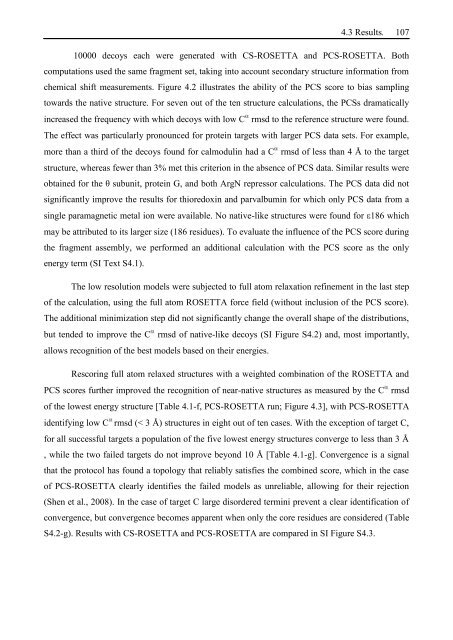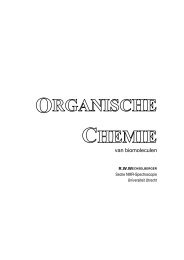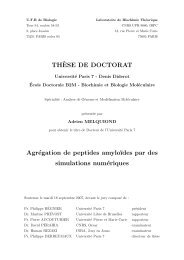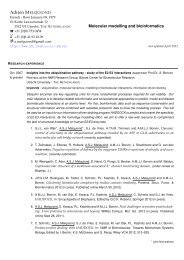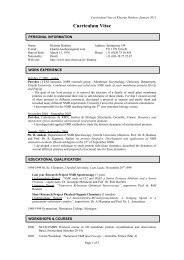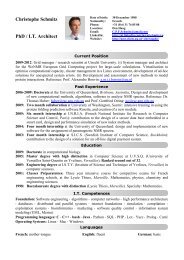Thesis Title: Subtitle - NMR Spectroscopy Research Group
Thesis Title: Subtitle - NMR Spectroscopy Research Group
Thesis Title: Subtitle - NMR Spectroscopy Research Group
Create successful ePaper yourself
Turn your PDF publications into a flip-book with our unique Google optimized e-Paper software.
4.3 Results. 107<br />
10000 decoys each were generated with CS-ROSETTA and PCS-ROSETTA. Both<br />
computations used the same fragment set, taking into account secondary structure information from<br />
chemical shift measurements. Figure 4.2 illustrates the ability of the PCS score to bias sampling<br />
towards the native structure. For seven out of the ten structure calculations, the PCSs dramatically<br />
increased the frequency with which decoys with low C rmsd to the reference structure were found.<br />
The effect was particularly pronounced for protein targets with larger PCS data sets. For example,<br />
more than a third of the decoys found for calmodulin had a C rmsd of less than 4 Å to the target<br />
structure, whereas fewer than 3% met this criterion in the absence of PCS data. Similar results were<br />
obtained for the θ subunit, protein G, and both ArgN repressor calculations. The PCS data did not<br />
significantly improve the results for thioredoxin and parvalbumin for which only PCS data from a<br />
single paramagnetic metal ion were available. No native-like structures were found for 186 which<br />
may be attributed to its larger size (186 residues). To evaluate the influence of the PCS score during<br />
the fragment assembly, we performed an additional calculation with the PCS score as the only<br />
energy term (SI Text S4.1).<br />
The low resolution models were subjected to full atom relaxation refinement in the last step<br />
of the calculation, using the full atom ROSETTA force field (without inclusion of the PCS score).<br />
The additional minimization step did not significantly change the overall shape of the distributions,<br />
but tended to improve the C rmsd of native-like decoys (SI Figure S4.2) and, most importantly,<br />
allows recognition of the best models based on their energies.<br />
Rescoring full atom relaxed structures with a weighted combination of the ROSETTA and<br />
PCS scores further improved the recognition of near-native structures as measured by the C rmsd<br />
of the lowest energy structure [Table 4.1-f, PCS-ROSETTA run; Figure 4.3], with PCS-ROSETTA<br />
identifying low C rmsd (< 3 Å) structures in eight out of ten cases. With the exception of target C,<br />
for all successful targets a population of the five lowest energy structures converge to less than 3 Å<br />
, while the two failed targets do not improve beyond 10 Å [Table 4.1-g]. Convergence is a signal<br />
that the protocol has found a topology that reliably satisfies the combined score, which in the case<br />
of PCS-ROSETTA clearly identifies the failed models as unreliable, allowing for their rejection<br />
(Shen et al., 2008). In the case of target C large disordered termini prevent a clear identification of<br />
convergence, but convergence becomes apparent when only the core residues are considered (Table<br />
S4.2-g). Results with CS-ROSETTA and PCS-ROSETTA are compared in SI Figure S4.3.


